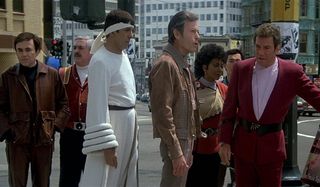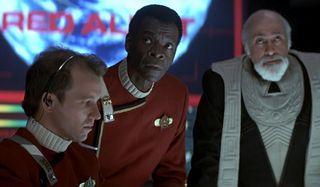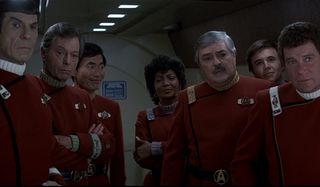How Star Trek IV’s Time Travel Works

A promise was made that after examining the time travel exploits of the Back to the Future series, similar examinations of temporal activities would be in the offing here at CinemaBlend. More specifically, it was promised that the far flung future of Star Trek IV: The Voyage Home’s 2286 would be called into question, as that film’s events saw the crew of the USS Enterprise venturing backwards by two centuries. Well, we’re back… we’re back from the future to tell you how it all worked in the movie that some would call the best Star Trek film ever.
However, since our last adventure saw the DeLorean destroyed by a freight train, it looks like our first big trip into the Star Trek cinematic canon will need a new vessel, not to mention a new method and an entirely new set of circumstances that start off this journey. Ah, time travel: you never know when, where or how the action is going to happen; but it’s always a good time! So brush up on your Klingon and humpback whale language skills, as we’re about to dive into how Star Trek IV’s time travel really works.

The Time Travel In Star Trek IV: The Voyage Home
The time travel in Star Trek IV: The Voyage Home isn’t terribly complicated, as it’s similar to that of what we saw in the current universe’s Back to the Future timeline. Which is good, considering the rules set forth in the alternate version of that series’ events were rather interesting to behold. That being said, Star Trek IV does have some really interesting views on time travel, and how CGI is used to depict such events.
Who's Time Traveling
The crew of the USS Enterprise: Admiral James T. Kirk (William Shatner,) Captain Spock (Leonard Nimoy,) Captain Montgomery Scott (James Doohan,) Commander Hikaru Sulu (George Takei,) Commander Nyota Uhura (Nichelle Nichols,) Commander Pavel Chekov (Walter Koenig) and Dr. Leonard McCoy (DeForest Kelly) are all the main crew of Star Trek IV: The Voyage Home’s mission. Though by the end of the journey, Dr. Gillian Taylor (Catherine Hicks) is in tow for the return to the future.
From When To When
Star Trek IV: The Voyage Home is a round trip, no-stops adventure between the far flung future of 2286 and a time warp to 1986. Though it’ll take more than a jump to the left and a step to the right to get this band of misfits home from temporal exile.
CINEMABLEND NEWSLETTER
Your Daily Blend of Entertainment News
The Purpose Of Their Trip
At the tail end of a loose trilogy that started with Star Trek II: The Wrath of Khan, the crew of the USS Enterprise find themselves on a mission to save the human race. After a probe searching for humpback whales in the year 2286 starts attacking the Earth’s atmosphere, our heroes must retrieve two specimens, George and Gracie, who are about to be released into the wild in 1986 San Francisco. So these whales aren’t exactly going to be missed by anyone but their minder, Dr. Taylor of the Cetacean Institute.

How Time Travel Happens In Star Trek IV: The Voyage Home
In Star Trek IV: The Voyage Home, time travel is achieved through some pretty strenuous circumstances. A vessel attempting to travel through time needs to calculate an exact slingshot orbit around the Sun, while speeding at close to Warp Factor 10. This is pretty hard no matter what ship you’re using, but it’s even harder when the only craft available is a rickety Klingon Bird of Prey. Time travel also requires a lot of energy, as the Dilithum Crystals of said vessel need a recharge through some nuclear energy stolen from the a naval vessel, coincidentally named the Enterprise, in 1986. When the conditions are right, one hell of an LDS trip awaits, as traveling in time apparently involves rudimentary CGI likenesses of all the participants as they travel through the time stream. Seriously, it’s weird, even for Star Trek.
The time travel that takes place in Star Trek IV: The Voyage Home is a very exact science, right down to calculating the location your vessel is supposed to wind up in. The Enterprise is extremely lucky to have Captain Spock on board to help, seeing as Christopher Lloyd was killed off in the previous film, Star Trek III: The Search for Spock. If only he’d had some sort of warning from the Klingon equivalent of Marty McFly before boarding the Enterprise. Though by the time Spock makes the suggestion of time travel, Admiral Kirk’s reaction ordering him to draw up the calculations confirms that this sort of enterprise is old hat to the USS Enterprise. And, as we all know, it’s not the only/last time travel mission we’ll see in the Star Trek movies.

Can History Be Changed As A Result Of Time Travel In Star Trek IV: The Voyage Home?
It’s actually a bit of a mixed bag when it comes to answering the question of whether or not history can be changed in Star Trek IV: The Voyage Home. This is because we see a clear example of things changing and a potential example of history actually being made because of this trip. But, starting with the basics, this is a singular timeline with actions existing in their own time and context. So there are no disappearing photographs or the future of our protagonists depending on a first kiss this time.
In fact, no past history is being rewritten when all is said and done in Star Trek IV's story. So when George and Gracie are brought to 2286, we see them waving off the nefarious probe, but the actions that took place before still happened in the future time period. And since those whales were going out to sea anyway, there was no way to keep tabs on them past that point. Though it does look like whales will still become extinct in the 21st century, only to be miracled back into the ecosystem through time travel. So history isn't really changed in that instance.
The one questionable moment of potentially altering the future comes when Scotty and McCoy make a deal with Plexicorp’s Dr. Nichols (Alex Henteloff) to produce the transparent aluminum they need to carry the whales safely into the future. With that material not existing in the ‘80s, Scotty basically gives Dr. Nichols the formula for free, with McCoy questioning if this is going to ruin the future timeline.
Interestingly enough, Scotty waves it off in Star Trek IV: The Voyage Home’s cinematic incarnation, by asking his shipmate, “How do we know he didn’t invent the thing?” However, [in the film’s novelization](https://memory-alpha.fandom.com/wiki/StarTrekIV:TheVoyageHome(novel), Mr. Scott knows damned well that Dr. Nichols did invent Transparent Aluminum, which means history was never changed in this instance as it was always the way things were meant to pan out. Time travel fans will recognize this as a “Predestination Paradox,” where a trip in time was always built into the fabric of history to begin with.

What Are the Consequences of Time Travel In Star Trek IV: The Voyage Home
Star Trek IV: The Voyage Home’s greatest consequence of time travel is the fact that humanity gets to live to see another several entries in the Star Trek motion picture canon. Strangely enough, that means the heroic Admiral Cartwright (Brock Peters) lives long enough to become the villain, as he’s part of the political intrigue that drives Star Trek VI: The Undiscovered Country. But on the more long term side of things, the USS Enterprise’s crew does a really good job of not screwing up the time continuum.
George and Gracie were always going to go into the wild, with no important moments relying on their existence; and the same could be said for Dr. Gillian Taylor, as she was really only close with her whale friends. Her existence in the future doesn’t screw anything up a bit, as all of her knowledge is from the past. When all is said and done, the shaky historical ground that the whole invention of transparent aluminum rests upon is the only potential quandary in Star Trek IV’s scenario, and it’s never mentioned again in the series. But as far as great consequences are concerned, it’s just humanity’s survival in the future that is effected by these actions.

My Friends... We're Home
At the end of Star Trek IV: The Voyage Home, home has indeed been voyaged to and saved! Humpback whales now exist in 2286, Captain Kirk is busted down a rank and given a new Enterprise for saving the human race, and it’ll all eventually be rendered useless thanks to events in the future past, but that’s a story for another time. Speaking of another time, we should probably lock in another adventure’s worth of discussion for next week. It might be a little too early to melt minds with Primer, and we’re probably not going to touch time loops like Palm Springs or Happy Death Day just yet.
So… why don’t we keep things simple with the clearest, most sensible timeline known to sci-fi audiences: The Terminator! It’s okay, folks, we’ll keep it limited to the Cameron timeline, and you’ve already got a head start on some of the rules with this week’s lesson in Bootstrap Paradoxes. But if you want to read up on the various timelines that exist throughout the non-canonical sequels, we’ll leave you some extra credit reading at the end. Which is where we are now; although, depending on how you’re traveling through time, this could be the beginning. In which case, don’t spoil the future for us, as we don’t want to jeopardize the timeline. Just meet us back here next week, and we’ll hash it all out in due time.

Mike Reyes is the Senior Movie Contributor at CinemaBlend, though that title’s more of a guideline really. Passionate about entertainment since grade school, the movies have always held a special place in his life, which explains his current occupation. Mike graduated from Drew University with a Bachelor’s Degree in Political Science, but swore off of running for public office a long time ago. Mike's expertise ranges from James Bond to everything Alita, making for a brilliantly eclectic resume. He fights for the user.
Most Popular






